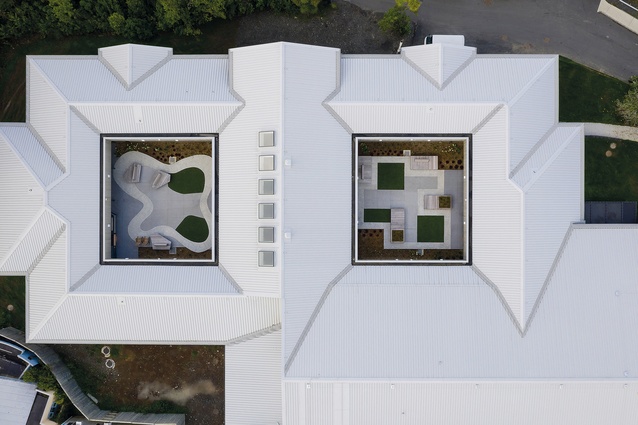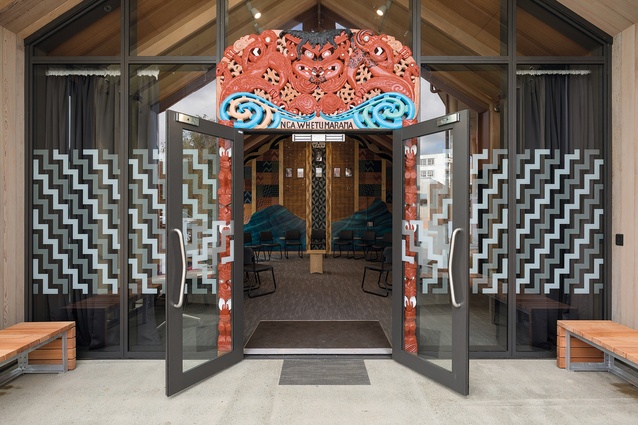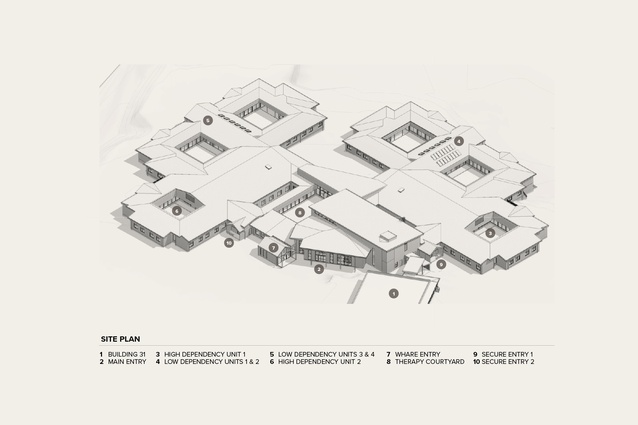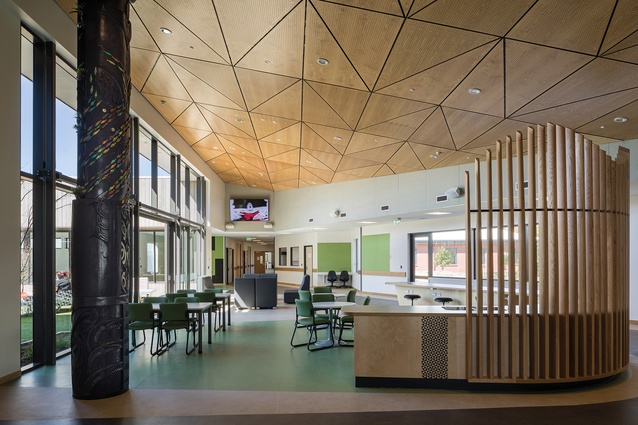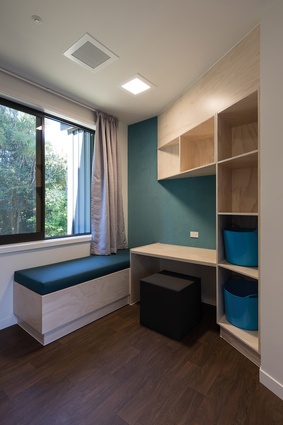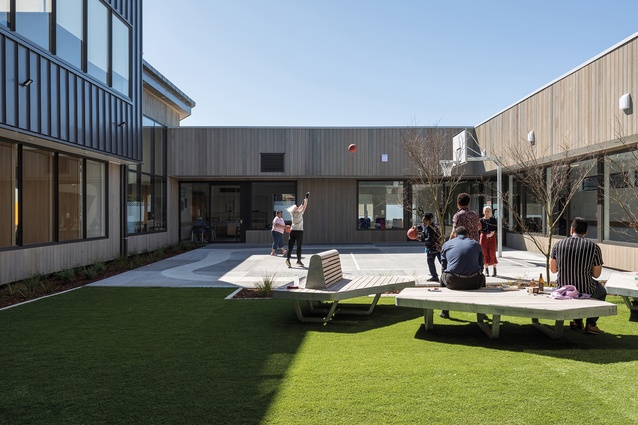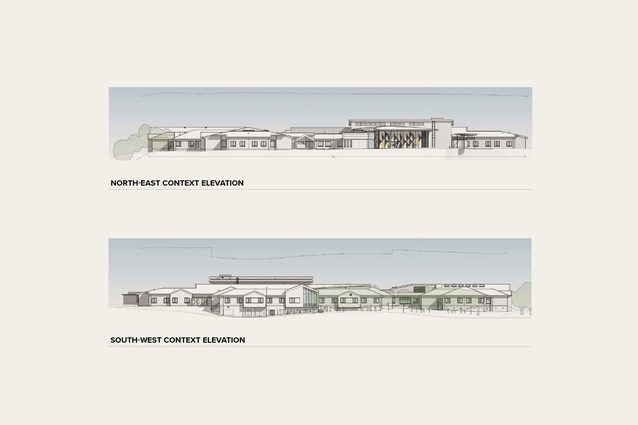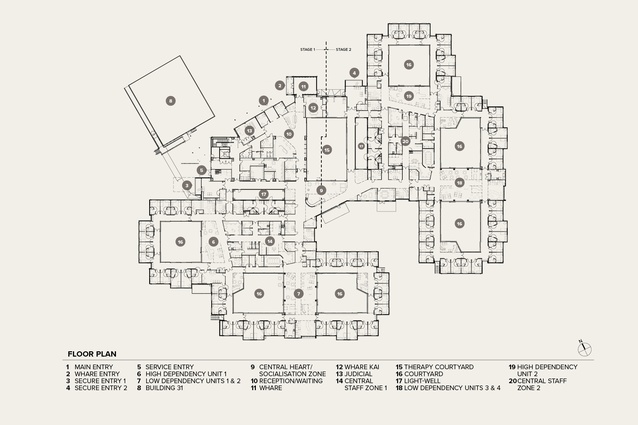An atmosphere of recovery
Dorita Hannah visits Klein Architects’ transformative Acute Mental Health Inpatient Unit, Tiaho Mai, and discovers a new era in therapeutic design.
We live in an era where the term ‘asylum’ relates to those dispossessed of a homeland who seek sanctuary elsewhere. While historically associated with institutions of care for the mentally ill, it is more enduringly aligned with a right to protection and a place safe from danger or hardship. And yet, the haunting Gothic image of a ‘lunatic asylum’ as a state-run institution for detaining, confining and safeguarding those proclaimed ‘mad’ — previously looked after by family, religious institutions and community — was the precursor of the psychiatric hospital, emphasising seclusion and restraint over care. This is reinforced by popular culture, especially film and television, where such masonry piles bathed in shadow are tinged with terror, capturing a failed 19th-century notion of monuments to moral architecture. However, the history of psychiatric institutions is one of buildings outliving the specific set of assumptions and circumstances that originally gave rise to them. Middlemore Hospital’s recently completed Acute Mental Health Inpatient Unit proposes and performs a refreshed typology in which night’s muted light sources are summoned to illuminate a regenerative atmosphere that enables recovery before a person re-enters the community.
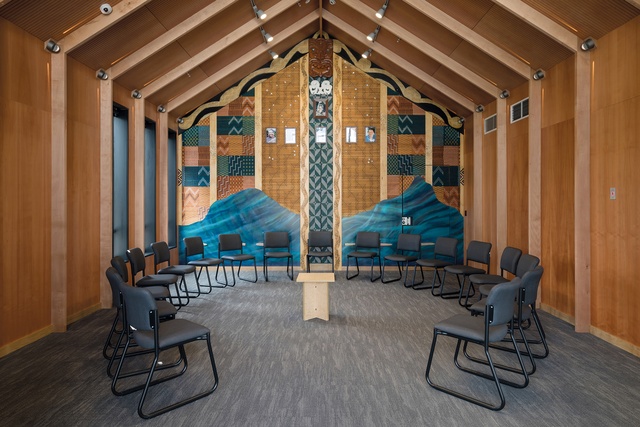

Tiaho Mai — ‘the light that comes from the moon and the stars — shine here’ — is the name gifted by mana whenua to the original South Auckland unit managed by Counties Manukau Health, which was demolished and rebuilt in two stages to a new design by Klein Architects. Construction of the second stage was completed during New Zealand’s Covid lockdown in September 2020. The opportunity to view, in order to review, this new facility was repeatedly stymied not only by the effects of the pandemic but by its sensitive nature as a residency for adults requiring round-the-clock attention in a specialised therapeutic environment. Although welcoming visitors into its light-filled publicly accessible zones during appointed hours, the architecture unfolds as a complex spatial system that must serve the specific needs and requirements of those who live and work within its supple, yet carefully controlled, borders. Herein lies the project’s extraordinary collaborative achievement in having shaped a compassionate and uplifting environment. It now forms a global exemplar for this particularly fraught architectural typology, which has moved over the centuries from carceral and paternalistic asylum to a new era of ‘salutogenic design’.
The history of psychiatric care is one of progressive institutional developments, with each new wave of thinking presenting innovative architectural solutions. Klein Architects have been highly influenced by salutogenesis, formulated in the late 1970s by American-Israeli sociologist Aaron Antonovsky to identify the stressors that disturb a body’s homeostasis and sense of coherence, affecting the comprehensibility, manageability and meaningfulness of our daily lives. In the 1990s, this was applied to architecture as Salutogenic Design by Alan Dilani of Stockholm’s Karolinska Institute and, more recently, to Psychological Design by Sydney-based Jan Golembiewski, who advocates incorporating socio-environmental influences, such as nature, fresh air and natural light, in order to mitigate stressors rather than operate as a tool for either healing or control. Such regulatory architecture can be found in the unprepossessing building that previously occupied the site, with its wings of rooms off long, dead-end corridors radiating from central control points. Informed by the 18th-century panopticon proposed by English social theorist Jeremy Bentham as a constructed system of spatial discipline, this outmoded and punitive hub-and-spoke plan — emphasising surveillance and undermining agency — has been applied in equal measure to the design of both prisons and psychiatric hospitals.

As asylum — sanctuary, refuge and retreat — Tiaho Mai places patient recovery at the centre of design. It does so by deftly and sympathetically navigating between the exigencies of both care and restraint for those inpatients whose instincts are often towards fight-or-flight and, even more acutely, radical self-harm. The challenge was, therefore, to design a unit that minimises means of escape and suicide through anti-ligature fixings, alarmed sensors registering weight on doors, invisible electronic locking systems and external walls that cannot be climbed: all while offering airy, pleasant surroundings with views of nature and places within which to retreat or commune. Lines of sight from the necessarily more prosaic administrative areas of nurses’ stations and dedicated staff zones are ameliorated by dispersed ‘touch-down spaces’ within the inpatient’s social realm open to visiting family and friends. This spatial integration of health workers facilitates a more discernible form of passive surveillance for seeing and being seen — as opposed to the concealed viewer in the panopticon — as well as spontaneous interactions and engagement between service users and staff.

The project’s rigorous co-design process and research into Scandinavian and Australian precedents led to adopting and developing a courtyard model in which wide, high corridors with glazed seating areas enwrap several generous open enclosures. Landscaped by Isthmus, these courtyards are designed to create a range of safe havens, although the patches of artificial grass (sadly proliferating throughout our cities) seem to contradict salutogenic principles. The 76 single bedrooms, each with its own en suite, are deinstitutionalised with timber cabinetry and inbuilt daybeds under generous, openable windows, made possible by safety screens. Despite limited funding, this project’s many successful innovations were made possible by client commitment to a more home-like environment.
While budgetary spending went mainly into the interior aspect of the Unit, resulting in a generally unremarkable exterior, a series of public and private entries demonstrates revolutionary cultural and compassionate gestures. These further platform this facility as a global frontrunner in addressing its tangata whaiora — a term coined by Sir Mason Durie as ‘people seeking wellness’, which is so much more appropriate than ‘inpatient’, ‘service user’ or ‘consumer’. Informed by Māori tikanga (customary practices), the open space between car park and building forms an ātea (public forum) for ceremonial gathering before entering the Whare Ngā Whetū Mārama (‘House of the Bright Stars’). This carved meeting house serves as an alternative entry and calm place to welcome tangata whaiora on admission and is utilised by whānau and community throughout their care. Two gabled porches on either side of the building open onto small, gated courtyards that provide secure entries for those being admitted by police car. Considering the dignity of tangata whaiora, they improve upon the usual back entry with roller door, further imbuing this institutional architecture with a deliberately domestic scale and language.

The input and influences of Māori and Pasifika (who are over-represented and under-served in this arena) are visually threaded along a defined huanui (pathway) through the public spaces: from the entry whare and abstracted poutama patterning on the glazed entry façade; to the waka-shaped reception desk, lighting constellations embedded in panelled ceilings and O’Dell Toli’s central pou, co-decorated with the community. The design exemplifies a conceptual journey to wellness with décor facilitating movement, rest and orientation, while timber screening refers to the palisades of fortified pā that protect inhabitants from the outside world. These overt indigenous references inherent in the architecture enhance a sense of belonging and transform the front-of-house spaces into an inviting communal hub that stages whakawhanaungatanga as a process of establishing relationships. Materials, in-built furniture, colour and detailing radically deinstitutionalise the hospital environment, shaping elegant and robust spaces that ensure maximum aesthetic atmosphere with minimum chances of damage to infrastructure and bodies within a place where risk management is downplayed while ever-present.
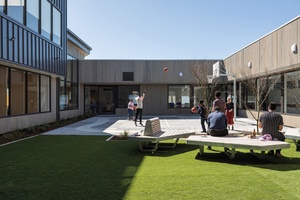
During the Covid-19 pandemic of the last few years, we have learnt to understand what and who is ‘essential’ to a society faced with crises and their traumatic effects. A more holistic approach to health is called for that extends beyond physical and mental parameters. This is exemplified in Durie’s well-being model of Te Whare Tapa Whā — ‘the house with four walls’ — that draws on architecture itself to emphasise stability, assemblage and shelter. While our current government is placing much-needed emphasis on well-being, there is considerable work still to be done, especially in a country where psychiatric health has increasingly depended on medication and emergency facilities that place the ambulance at the bottom of the cliff.
A professional journal article such as this doesn’t begin to address the complexity of a project such as Tiaho Mai. Nor does it give justice to the consultation, care and responsibility taken by Klein Architects which, in researching key precedents and best practices within the field of acute mental health architecture, has established itself as an international trailblazer. The success of the Unit is evident in the frequent positive feedback received from service users and their whānau. It is a testament to architecture’s transformative power when serving those asylum-seekers within our own society.
Klein Architects specialise in design for peoples’ well-being. For more information head to their website.
Isthmus Group are a multidisciplinary landscape architecture and urban design studio operating from three locations across Aotearoa. For more information head to their website.

